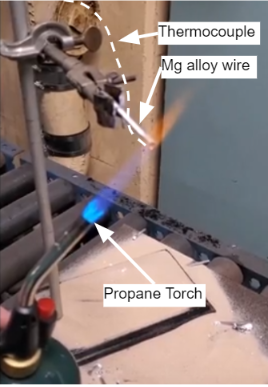Flammability Testing
Jump to navigation
Jump to search
The following is an SOP on writing a flammability testing specifically for magnesium however can be used for other metals with similar ignition temperatures and limited EHS risks.
Loss Prevention (Saftey)
- Magnesium burns at temperatures above 2000 °C, so care must be taken to avoid contact with the metal while burning
- Mg will give off a bright light that can cause eye damage welding masks or special eye protection should be used. Alternatively, avoid looking at the burning magnesium.
- Clothing should not be very flammable in case of sparking
- Water WILL NOT extinguish the fire but will make it worse. A bucket of sand or ideally a MET-L-X Class D fire extinguisher should be kept on hand to extinguish an out of control fire.
- Sand should be used below the testing environment in case the sample falls
Procedure
- Gather clamp, ring stand, ring support, sand, propane torch, large baking tray, something to hold the torch in place (NOT UNDER THE Mg), and a stopwatch.
- Set up the stand and propane torch as shown in the picture. This set up will be set up on the baking tray filled with about 2" of sand.
- Place the Mg wire into the clap such that the end of the wire will be covered in flame once the torch is ignited.
- Have a second person hold the stopwatch while following directions to light the torch.
- The flame should be consistent between measurements so take note of the flame used for the initial test and adjust subsequent tests to match.
- Once the flame is lit and is in contact with the Mg wire, the stop watch should be started.
- Watch the Mg wire and once a white light is observed the stopwatch should be stopped.
- Turn off the torch and let the Mg wire burn out, taking care not to give the Mg wire fuel to start a larger fire.
- Once Mg has burned out and is either in the sand or still in wire form remove from clamps and sand.
- Either disassemble set up taking care not to mix sand again due to Mg contamination or set up for another test.
